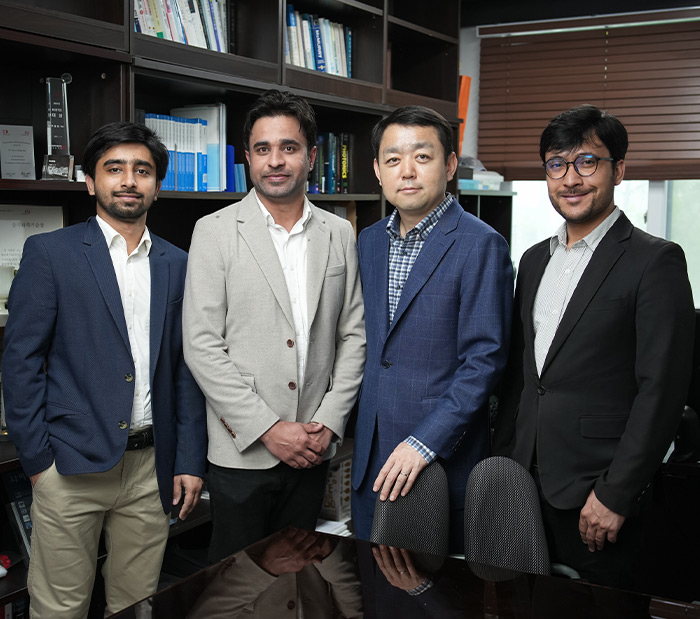Research Stories
Development of MXene Hybrid Material with Stealth Function of Microwave Absorption
Professor Chong Min Koo’s research team at Sungkyunkwan University
Advanced Materials Science and Engineering
Prof.
KOO, CHONG MIN
A research team led by Professor Chong Min Koo of the Department of Advanced Material Engineering at Sungkyunkwan University (President Yoo Ji-beom) announced on the 4th that they have developed an electromagnetic wave absorbing material that can be used in stealth* defense technology and electromagnetic wave shielding technology of high-intensity communication/electronic devices.
* Stealth technology: A technology that absorbs electromagnetic waves and prevents them from appearing on radar images, making it difficult to detect aircraft and missiles early by radar.
The development of an electromagnetic wave absorbing material is attracting a lot of attention as a stealth technology that disables radar detection and a technology essential for blocking and removing harmful electromagnetic waves from communication/electronic devices.
Currently, domestic stealth fighter paint technology relies on foreign countries for a large part, so research and development are needed. In order to develop electromagnetic wave absorbing materials for high-density electronic devices, it is necessary to develop material that is light, thin, and excellent in coating processability.
Accordingly, the research team led by Professor Chong Min Koo at Sungkyunkwan University developed a material with efficient stealth performance and electromagnetic absorption characteristics using a self-assembled structure of two-dimensional nanomaterial MXene and zeolitic imidazolate framework (ZIP).
Using MXene's negative surface charge and ZIF' positive surface charge, the research team produced a material with self-assembled hybrid nanostructure originated from electrostatic interaction. This material has a very strong built-in electric field (BIEF) formed at the heterogeneous interface due to the opposite (negative and positive) surface charge characteristics of each nanomaterial. Strong dielectric loss induced by the internal electric field resulted in a 2.5mm thick stealth performance (RL) in the X-band (8-12 GHz) frequency and excellent electromagnetic absorption properties and stealth performance with 47.5 dB with an effective bandwidth of 6.3 GHz.
The research team confirmed that the developed MXene nanomaterial exhibits excellent electromagnetic wave shielding and absorption performance in a wide range of frequencies from low-frequency radio waves (RF) to X-band, terahertz, and infrared rays. By utilizing this, it can be used not only for stealth applications but also for EMI shielding applications of communication/electronic devices, infrared stealth, and infrared counterfeiting prevention.
Professor Chong Min Koo at Sungkyunkwan University explained, "MXene nanomaterials can be used as stealth materials for business of the domestic KF-21 stealth fighter production in the future. In addition, they can be used as electromagnetic wave absorbing materials for state-of-the-art, highly integrated electronic device and electric vehicles.
This work was financially supported by National Research Foundation of Korea(NRF) grant, Nano·Material Technology Development Program, funded by the Ministry of Science, ICT and Future Planning, and POSCO's research project. This work was published in the journal of Advanced Materials (IF: 29.4) and Nature Reviews Electrical Engineering at the same time.
1. Zhenguo Gao, Aamir Iqbal, Tufail Hassan, Shengchong Hui, Hongjing Wu*, Chong Min Koo*, “Tailoring Built‐in Electric Field in a Self‐Assembled Zeolitic Imidazolate Framework/MXene Nanocomposites for Microwave Absorption”, Advanced Materials 2024, 2311411 (https://doi.org/10.1002/adma.202311411)
2. Aamir Iqbal, Tufail Hassan, Shabbir Madad Naqvi, Yury Gogotsi, Chong Min Koo*, "MXenes for multispectral electromagnetic shielding”, Nature Reviews Electrical Engineering 2024, 1, 180-198.
[Figure 1] MXene two-dimensional nanomaterial structure and excellent electromagnetic wave shielding effect in a wide frequency range from radio waves to infrared rays.
[Figure 2] Electrostatically self-assembled structure of MXene-ZIF nanocomposite with an artificial built-in electric field (BIEF) at its heterointerfaces.
[Figure 3] The effect of internal electric field (BIEF) at the interface of MXene-ZIF hybrid and their excellent microwave absorbing (RL) performances.


